pH值对十二胺在碳钢表面的吸附行为及缓蚀机理的影响
- 格式:pdf
- 大小:1.66 MB
- 文档页数:7
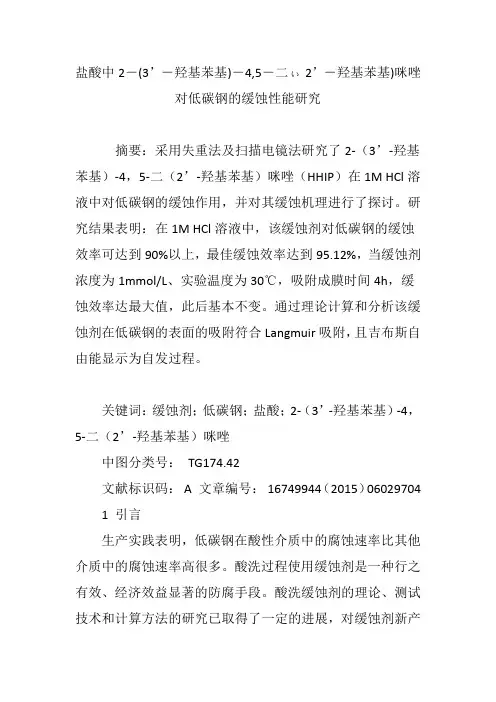
盐酸中2―(3’―羟基苯基)―4,5―二ぃ2’―羟基苯基)咪唑对低碳钢的缓蚀性能研究摘要:采用失重法及扫描电镜法研究了2-(3’-羟基苯基)-4,5-二(2’-羟基苯基)咪唑(HHIP)在1M HCl溶液中对低碳钢的缓蚀作用,并对其缓蚀机理进行了探讨。
研究结果表明:在1M HCl溶液中,该缓蚀剂对低碳钢的缓蚀效率可达到90%以上,最佳缓蚀效率达到95.12%,当缓蚀剂浓度为1mmol/L、实验温度为30℃,吸附成膜时间4h,缓蚀效率达最大值,此后基本不变。
通过理论计算和分析该缓蚀剂在低碳钢的表面的吸附符合Langmuir吸附,且吉布斯自由能显示为自发过程。
关键词:缓蚀剂;低碳钢;盐酸;2-(3’-羟基苯基)-4,5-二(2’-羟基苯基)咪唑中图分类号:TG174.42文献标识码:A 文章编号:16749944(2015)060297041 引言生产实践表明,低碳钢在酸性介质中的腐蚀速率比其他介质中的腐蚀速率高很多。
酸洗过程使用缓蚀剂是一种行之有效、经济效益显著的防腐手段。
酸洗缓蚀剂的理论、测试技术和计算方法的研究已取得了一定的进展,对缓蚀剂新产品的开发和应用起到了一定的促进作用[1]。
目前,有机缓蚀剂已经成为缓蚀剂发展的重要方向。
有机缓蚀剂由电负性大的O、N、S和P等原子为中心的极性基团和以C、H原子组成的非极性基所组成,极性基团吸附在材料表面,改变了双电层的结构,提高了阳极反应的活化能;而非极性基团在金属表面形成疏水薄膜,成为腐蚀反应有关物质的扩散屏障,从而抑制腐蚀反应[2~5]。
酸洗缓蚀剂方面,Bentiss 及其研究小组做了大量的工作,先后合成并测试了杂环系列几十种化合物在酸性溶液中对金属的腐蚀行为,并结合SEM,XPS,量子化学计算等方法对其机理进行了探讨。
其中一个系列的杂环化合物是以一个五元杂环为基本单元,包括噻二唑、三氮唑及?f二唑[6~10]。
咪唑类化合物(基本单元结构如图1所示)是一种应用较为广泛的酸洗缓蚀剂,国内外研究也较多。
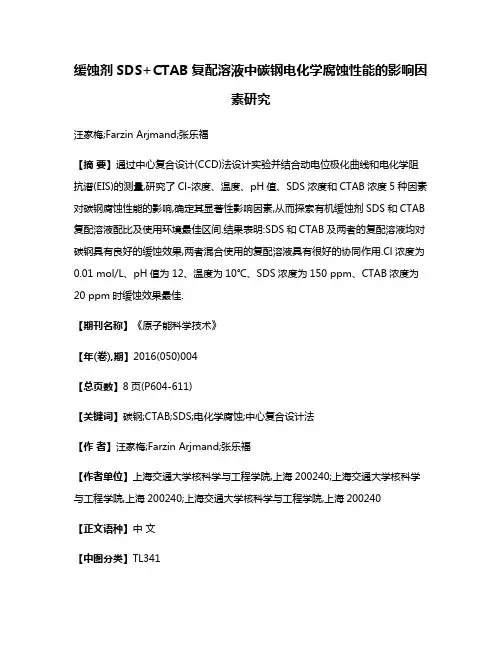
缓蚀剂SDS+CTAB复配溶液中碳钢电化学腐蚀性能的影响因素研究汪家梅;Farzin Arjmand;张乐福【摘要】通过中心复合设计(CCD)法设计实验并结合动电位极化曲线和电化学阻抗谱(EIS)的测量,研究了Cl-浓度、温度、pH值、SDS浓度和CTAB浓度5种因素对碳钢腐蚀性能的影响,确定其显著性影响因素,从而探索有机缓蚀剂SDS和CTAB 复配溶液配比及使用环境最佳区间.结果表明:SDS和CTAB及两者的复配溶液均对碳钢具有良好的缓蚀效果,两者混合使用的复配溶液具有很好的协同作用.Cl浓度为0.01 mol/L、pH值为12、温度为10℃、SDS浓度为150 ppm、CTAB浓度为20 ppm时缓蚀效果最佳.【期刊名称】《原子能科学技术》【年(卷),期】2016(050)004【总页数】8页(P604-611)【关键词】碳钢;CTAB;SDS;电化学腐蚀;中心复合设计法【作者】汪家梅;Farzin Arjmand;张乐福【作者单位】上海交通大学核科学与工程学院,上海200240;上海交通大学核科学与工程学院,上海200240;上海交通大学核科学与工程学院,上海200240【正文语种】中文【中图分类】TL341缓蚀剂在防护工程中的应用,是腐蚀科学与表面工程学科发展的一项重要成就。
多年来,缓蚀剂的开发应用在化工、石油、电力、机械、金属加工、交通运输、核能及航天等领域中起着极其重要的作用[1],其中有机缓蚀剂由于其相较无机缓蚀剂而言,具有用量低、效率高、污染小等独特优点,逐渐成为国内外工业金属防护研究的主流[2]。
碳钢是核电厂冷却水设备的主要材料,研究不同缓蚀剂对其缓蚀机理和缓蚀效率并探寻最佳缓蚀剂对于核电厂的安全稳定运行至关重要。
已有大量研究[3-9]表明,表面活性剂十二烷基硫酸钠(SDS)和十六烷基三甲基溴化铵(CTAB)等作为有机缓蚀剂,其腐蚀机理分别是通过S和N提供共对电子形成化学键吸附并覆盖在金属表面,一方面可改变金属的表面电荷状态和界面性质,使金属的表面能降低,增加腐蚀活化能,从而减缓腐蚀速率;另一方面,能形成疏水保护膜,阻碍与腐蚀反应有关的电荷或物质转移,使腐蚀速率减小[3]。
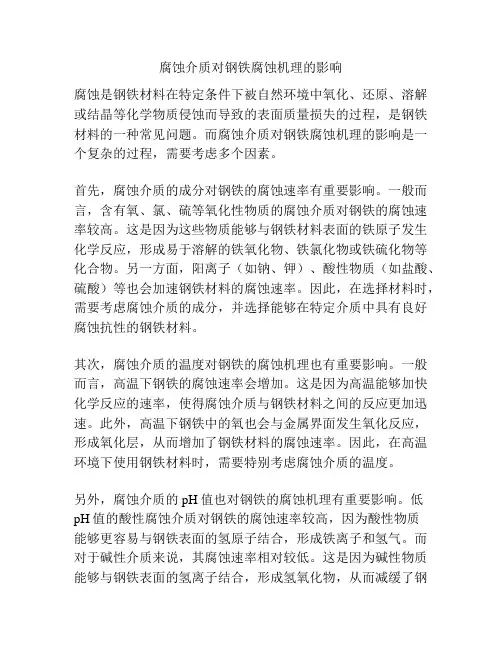
腐蚀介质对钢铁腐蚀机理的影响腐蚀是钢铁材料在特定条件下被自然环境中氧化、还原、溶解或结晶等化学物质侵蚀而导致的表面质量损失的过程,是钢铁材料的一种常见问题。
而腐蚀介质对钢铁腐蚀机理的影响是一个复杂的过程,需要考虑多个因素。
首先,腐蚀介质的成分对钢铁的腐蚀速率有重要影响。
一般而言,含有氧、氯、硫等氧化性物质的腐蚀介质对钢铁的腐蚀速率较高。
这是因为这些物质能够与钢铁材料表面的铁原子发生化学反应,形成易于溶解的铁氧化物、铁氯化物或铁硫化物等化合物。
另一方面,阳离子(如钠、钾)、酸性物质(如盐酸、硫酸)等也会加速钢铁材料的腐蚀速率。
因此,在选择材料时,需要考虑腐蚀介质的成分,并选择能够在特定介质中具有良好腐蚀抗性的钢铁材料。
其次,腐蚀介质的温度对钢铁的腐蚀机理也有重要影响。
一般而言,高温下钢铁的腐蚀速率会增加。
这是因为高温能够加快化学反应的速率,使得腐蚀介质与钢铁材料之间的反应更加迅速。
此外,高温下钢铁中的氧也会与金属界面发生氧化反应,形成氧化层,从而增加了钢铁材料的腐蚀速率。
因此,在高温环境下使用钢铁材料时,需要特别考虑腐蚀介质的温度。
另外,腐蚀介质的pH值也对钢铁的腐蚀机理有重要影响。
低pH值的酸性腐蚀介质对钢铁的腐蚀速率较高,因为酸性物质能够更容易与钢铁表面的氢原子结合,形成铁离子和氢气。
而对于碱性介质来说,其腐蚀速率相对较低。
这是因为碱性物质能够与钢铁表面的氢离子结合,形成氢氧化物,从而减缓了钢铁的腐蚀速率。
因此,在选择腐蚀介质时,需要考虑其pH值,并进行相应的防腐措施。
此外,腐蚀介质中的氧含量也对钢铁材料的腐蚀机理有影响。
氧气是钢铁材料的主要腐蚀介质之一,但适量的氧气可以形成钢铁表面的氧化膜,从而减缓钢铁的腐蚀速率。
然而,当氧气含量过高时,会加速钢铁材料的腐蚀速率,因为氧气能与钢铁表面的铁原子发生更多的氧化反应。
因此,在腐蚀介质中氧气含量的控制也是减少钢铁腐蚀的重要措施之一。
总的来说,腐蚀介质对钢铁腐蚀机理的影响取决于介质的成分、温度、pH值和氧含量等因素。
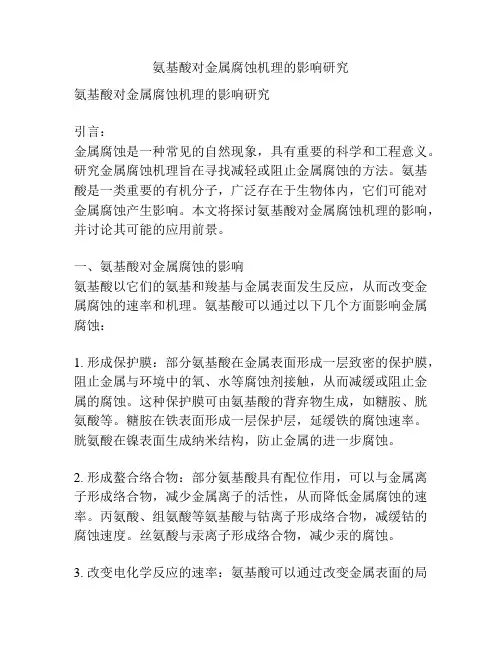
氨基酸对金属腐蚀机理的影响研究氨基酸对金属腐蚀机理的影响研究引言:金属腐蚀是一种常见的自然现象,具有重要的科学和工程意义。
研究金属腐蚀机理旨在寻找减轻或阻止金属腐蚀的方法。
氨基酸是一类重要的有机分子,广泛存在于生物体内,它们可能对金属腐蚀产生影响。
本文将探讨氨基酸对金属腐蚀机理的影响,并讨论其可能的应用前景。
一、氨基酸对金属腐蚀的影响氨基酸以它们的氨基和羧基与金属表面发生反应,从而改变金属腐蚀的速率和机理。
氨基酸可以通过以下几个方面影响金属腐蚀:1. 形成保护膜:部分氨基酸在金属表面形成一层致密的保护膜,阻止金属与环境中的氧、水等腐蚀剂接触,从而减缓或阻止金属的腐蚀。
这种保护膜可由氨基酸的背弃物生成,如糖胺、胱氨酸等。
糖胺在铁表面形成一层保护层,延缓铁的腐蚀速率。
胱氨酸在镍表面生成纳米结构,防止金属的进一步腐蚀。
2. 形成螯合络合物:部分氨基酸具有配位作用,可以与金属离子形成络合物,减少金属离子的活性,从而降低金属腐蚀的速率。
丙氨酸、组氨酸等氨基酸与钴离子形成络合物,减缓钴的腐蚀速度。
丝氨酸与汞离子形成络合物,减少汞的腐蚀。
3. 改变电化学反应的速率:氨基酸可以通过改变金属表面的局部电化学环境,改变金属与腐蚀剂的反应速率。
赖氨酸可以改变铁的阳极反应速率,减缓其腐蚀。
二、氨基酸在金属腐蚀研究中的应用氨基酸对金属腐蚀机理的影响有助于探索减少金属腐蚀的方法,具有重要的应用前景。
1. 防腐蚀涂层:通过控制氨基酸在金属表面的生成和组装,可以制备具有优异防腐蚀性能的涂层。
利用氨基酸的自组装特性,可以制备出致密的氨基酸膜,形成保护层,从而提高金属的抗腐蚀能力。
2. 抗氢脆性材料:氢脆是金属在受到氢的影响下变脆的现象。
氨基酸可以防止金属吸收和扩散氢,从而减少氢脆。
利用氨基酸的抗氢脆性能,可以制备出具有优异抗氢脆性能的金属材料,广泛应用于航空、能源等领域。
3. 腐蚀抑制剂:将氨基酸作为腐蚀抑制剂添加到金属腐蚀介质中,可以有效降低金属的腐蚀速率。
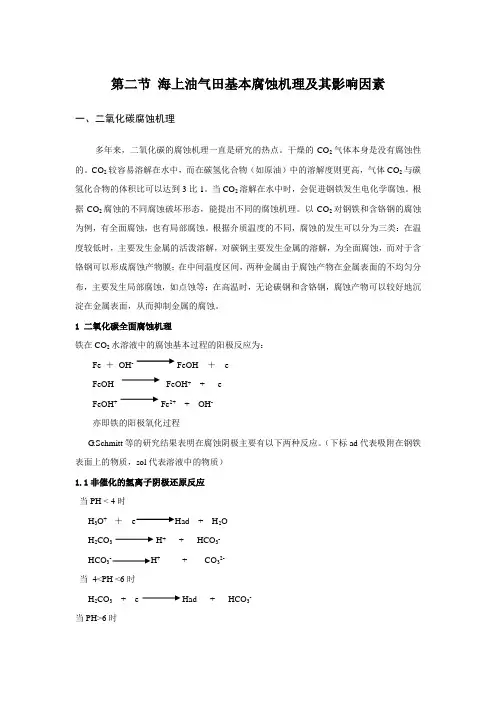
第二节海上油气田基本腐蚀机理及其影响因素一、二氧化碳腐蚀机理多年来,二氧化碳的腐蚀机理一直是研究的热点。
干燥的CO2气体本身是没有腐蚀性的。
CO2较容易溶解在水中,而在碳氢化合物(如原油)中的溶解度则更高,气体CO2与碳氢化合物的体积比可以达到3比1。
当CO2溶解在水中时,会促进钢铁发生电化学腐蚀。
根据CO2腐蚀的不同腐蚀破坏形态,能提出不同的腐蚀机理。
以CO2对钢铁和含铬钢的腐蚀为例,有全面腐蚀,也有局部腐蚀。
根据介质温度的不同,腐蚀的发生可以分为三类:在温度较低时,主要发生金属的活泼溶解,对碳钢主要发生金属的溶解,为全面腐蚀,而对于含铬钢可以形成腐蚀产物膜;在中间温度区间,两种金属由于腐蚀产物在金属表面的不均匀分布,主要发生局部腐蚀,如点蚀等;在高温时,无论碳钢和含铬钢,腐蚀产物可以较好地沉淀在金属表面,从而抑制金属的腐蚀。
1 二氧化碳全面腐蚀机理铁在CO2水溶液中的腐蚀基本过程的阳极反应为:Fe +OH-FeOH + eFeOH FeOH++ eFeOH+Fe2++ OH-亦即铁的阳极氧化过程G.Schmitt等的研究结果表明在腐蚀阴极主要有以下两种反应。
(下标ad代表吸附在钢铁表面上的物质,sol代表溶液中的物质)1.1非催化的氢离子阴极还原反应当PH < 4时H3O+ + e Had + H2OH2CO3H++ HCO3-HCO3-H++ CO32-当4<PH <6时H2CO3+ e Had + HCO3-当PH>6时2HCO3- +2e H2+ 2CO32-1.2表面吸附CO2,ad的氢离子催化还原反应CO2,sol CO2,adCO2,ad + H2O H2CO3,adH2CO3,ad + e + HCO3-,adH3O+ad + e Had + H2OH2CO3,ad + H3O+2CO3,ad + H2O两种阴极反应的实质都是由于CO2溶解后形成的HCO3-电离出的H+的还原过程。
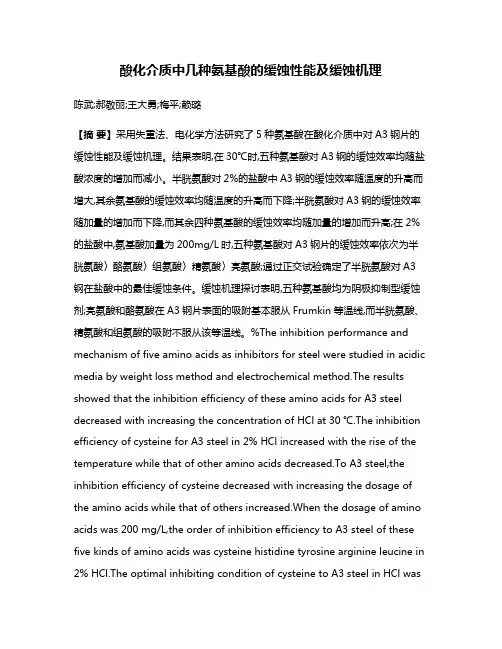
酸化介质中几种氨基酸的缓蚀性能及缓蚀机理陈武;郝敬丽;王大勇;梅平;赖璐【摘要】采用失重法、电化学方法研究了5种氨基酸在酸化介质中对A3钢片的缓蚀性能及缓蚀机理。
结果表明,在30℃时,五种氨基酸对A3钢的缓蚀效率均随盐酸浓度的增加而减小。
半胱氨酸对2%的盐酸中A3钢的缓蚀效率随温度的升高而增大,其余氨基酸的缓蚀效率均随温度的升高而下降;半胱氨酸对A3钢的缓蚀效率随加量的增加而下降,而其余四种氨基酸的缓蚀效率均随加量的增加而升高;在2%的盐酸中,氨基酸加量为200mg/L时,五种氨基酸对A3钢片的缓蚀效率依次为半胱氨酸〉酪氨酸〉组氨酸〉精氨酸〉亮氨酸;通过正交试验确定了半胱氨酸对A3钢在盐酸中的最佳缓蚀条件。
缓蚀机理探讨表明,五种氨基酸均为阴极抑制型缓蚀剂;亮氨酸和酪氨酸在A3钢片表面的吸附基本服从Frumkin等温线,而半胱氨酸、精氨酸和组氨酸的吸附不服从该等温线。
%The inhibition performance and mechanism of five amino acids as inhibitors for steel were studied in acidic media by weight loss method and electrochemical method.The results showed that the inhibition efficiency of these amino acids for A3 steel decreased with increasing the concentration of HCl at 30 ℃.The inhibition efficiency of cysteine for A3 steel in 2% HCl increased with the rise of the temperature while that of other amino acids decreased.To A3 steel,the inhibition efficiency of cysteine decreased with increasing the dosage of the amino acids while that of others increased.When the dosage of amino acids was 200 mg/L,the order of inhibition efficiency to A3 steel of these five kinds of amino acids was cysteine histidine tyrosine arginine leucine in 2% HCl.The optimal inhibiting condition of cysteine to A3 steel in HCl wasconfirmed through an orthogonal test.The results of the corrosion inhibition mechanism study show that all of these amino acids are cathodic inhibitors and the adsorption of leucine and histidine on A3 steel obeys the Frumkin equation while the adsorption of other amino acids do not obey it.【期刊名称】《腐蚀与防护》【年(卷),期】2012(033)005【总页数】5页(P390-393,399)【关键词】氨基酸;缓蚀效率;腐蚀机理;酸化介质【作者】陈武;郝敬丽;王大勇;梅平;赖璐【作者单位】长江大学化学与环境工程学院,荆州430023;长江大学化学与环境工程学院,荆州430023;长江大学化学与环境工程学院,荆州430023;长江大学化学与环境工程学院,荆州430023;长江大学化学与环境工程学院,荆州430023【正文语种】中文【中图分类】TG174.42氨基酸是分子中兼具有碱性氨基和酸性羧基的两性化合物,不但可以通过蛋白质水解制得,且在自然环境中能够全部分解成为缓蚀剂研究中受到关注的化合物[1,2]。
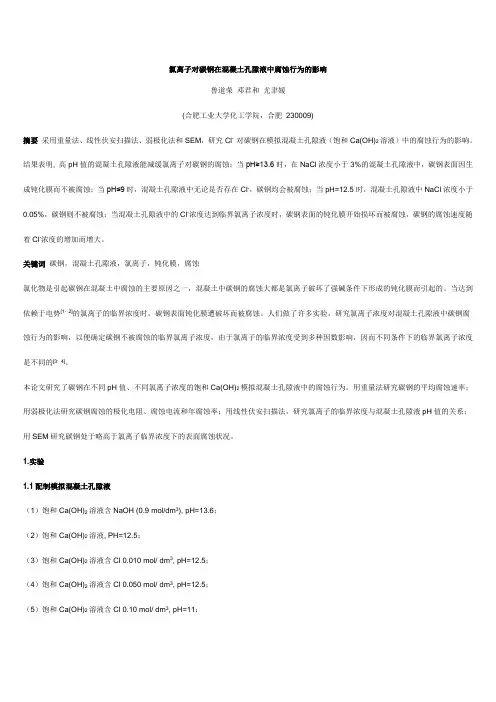
氯离子对碳钢在混凝土孔隙液中腐蚀行为的影响鲁道荣邓君和尤聿媛(合肥工业大学化工学院,合肥230009)摘要采用重量法、线性伏安扫描法、弱极化法和SEM,研究Cl- 对碳钢在模拟混凝土孔隙液(饱和Ca(OH)2溶液)中的腐蚀行为的影响。
结果表明, 高pH值的混凝土孔隙液能减缓氯离子对碳钢的腐蚀;当pH≥13.6时,在NaCl浓度小于3%的混凝土孔隙液中,碳钢表面因生成钝化膜而不被腐蚀;当pH≤9时,混凝土孔隙液中无论是否存在Cl-,碳钢均会被腐蚀;当pH=12.5时,混凝土孔隙液中NaCl浓度小于0.05%,碳钢则不被腐蚀;当混凝土孔隙液中的Cl-浓度达到临界氯离子浓度时,碳钢表面的钝化膜开始损坏而被腐蚀,碳钢的腐蚀速度随着Cl-浓度的增加而增大。
关键词碳钢,混凝土孔隙液,氯离子,钝化膜,腐蚀氯化物是引起碳钢在混凝土中腐蚀的主要原因之一,混凝土中碳钢的腐蚀大都是氯离子破坏了强碱条件下形成的钝化膜而引起的。
当达到依赖于电势[1,2]的氯离子的临界浓度时,碳钢表面钝化膜遭破坏而被腐蚀。
人们做了许多实验,研究氯离子浓度对混凝土孔隙液中碳钢腐蚀行为的影响,以便确定碳钢不被腐蚀的临界氯离子浓度,由于氯离子的临界浓度受到多种因数影响,因而不同条件下的临界氯离子浓度是不同的[3,4]。
本论文研究了碳钢在不同pH值、不同氯离子浓度的饱和Ca(OH)2模拟混凝土孔隙液中的腐蚀行为。
用重量法研究碳钢的平均腐蚀速率;用弱极化法研究碳钢腐蚀的极化电阻、腐蚀电流和年腐蚀率;用线性伏安扫描法,研究氯离子的临界浓度与混凝土孔隙液pH值的关系;用SEM研究碳钢处于略高于氯离子临界浓度下的表面腐蚀状况。
1.实验1.1配制模拟混凝土孔隙液(1)饱和Ca(OH)2溶液含NaOH (0.9 mol/dm3), pH=13.6;(2)饱和Ca(OH)2溶液, PH=12.5;(3)饱和Ca(OH)2溶液含Cl 0.010 mol/ dm3, pH=12.5;(4)饱和Ca(OH)2溶液含Cl 0.050 mol/ dm3, pH=12.5;(5)饱和Ca(OH)2溶液含Cl 0.10 mol/ dm3, pH=11;(6)饱和Ca(OH)2溶液含Cl 0.10 mol/ dm3, pH=10;(7)饱和Ca(OH)2溶液含Cl 0.60 mol/ dm3, pH=9;所用氢氧化钙;氢氧化钠;氯化钠和硝酸均为分析纯,溶液用二次蒸馏水配制。
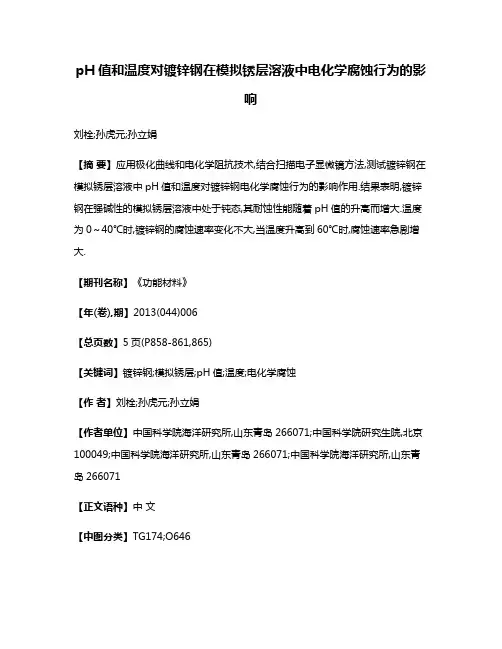
pH值和温度对镀锌钢在模拟锈层溶液中电化学腐蚀行为的影响刘栓;孙虎元;孙立娟【摘要】应用极化曲线和电化学阻抗技术,结合扫描电子显微镜方法,测试镀锌钢在模拟锈层溶液中pH值和温度对镀锌钢电化学腐蚀行为的影响作用.结果表明,镀锌钢在强碱性的模拟锈层溶液中处于钝态,其耐蚀性能随着pH值的升高而增大.温度为0~40℃时,镀锌钢的腐蚀速率变化不大,当温度升高到60℃时,腐蚀速率急剧增大.【期刊名称】《功能材料》【年(卷),期】2013(044)006【总页数】5页(P858-861,865)【关键词】镀锌钢;模拟锈层;pH值;温度;电化学腐蚀【作者】刘栓;孙虎元;孙立娟【作者单位】中国科学院海洋研究所,山东青岛266071;中国科学院研究生院,北京100049;中国科学院海洋研究所,山东青岛266071;中国科学院海洋研究所,山东青岛266071【正文语种】中文【中图分类】TG174;O6461 引言镀锌钢与外界环境接触后,其表面会形成1层腐蚀产物锈层。
镀锌钢在锈层下的腐蚀是持续时间最长、最主要的腐蚀形态。
环境因素(如pH值,温度)的变化不仅会影响镀锌钢锈层的形成机制、锈层的发展变化和锈层的组成结构,进而进一步影响镀锌钢的耐蚀性能[1,2]。
同时,由于环境因素导致锈层导电性、多孔性、离子选择性及还原性的改变也会对镀锌钢的电化学腐蚀行为产生重要影响[3,4]。
研究表明,镀锌钢在溶液中的初级腐蚀产物的主要成分为Zn(OH)2,Zn(OH)2在不同环境中对镀锌层耐蚀性能的影响差异显著[5,6]。
本文以饱和 Zn (OH)2 模拟镀锌钢的锈层环境[7],采用极化曲线、电化学阻抗谱和电子扫描显微镜(SEM)技术,研究了模拟锈层溶液中pH 值(pH 值=8.42、10.0、11.0、12.0和13.0)和温度(0、20、40和60℃)对镀锌钢电化学腐蚀行为的影响,对于镀锌钢在锈层中的腐蚀检测和保护有重要参考价值。
2 实验实验所用材料为上海宝钢生产的镀锌钢,其镀锌层化学成分(%,质量分数)为0.04C,0.2Mn,0.011P,0.008S,0.036Ti,余量Zn。
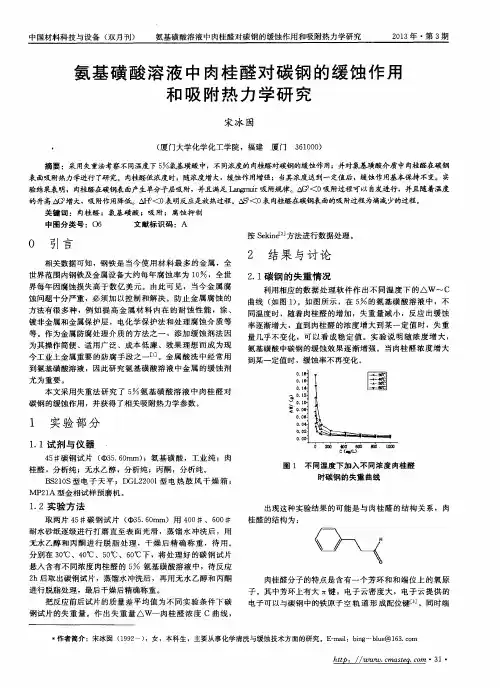

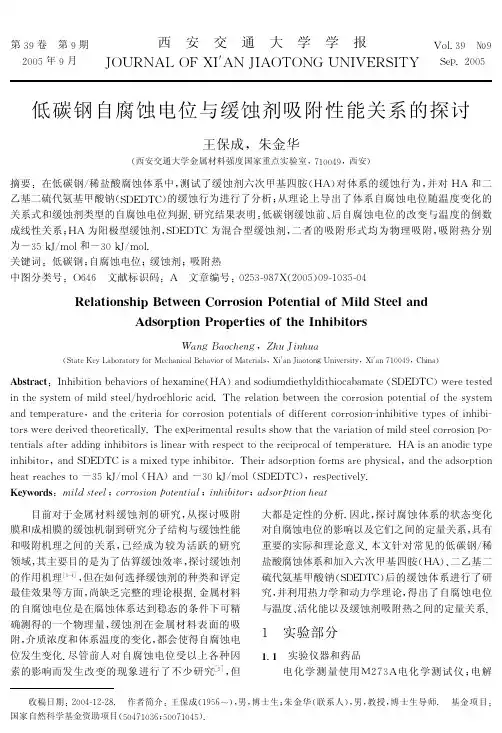
在自然界,正常温度下,水的PH值一般在4.3--10.0之间,碳钢在这样的水溶液中,它的表面常常形成氢氧化物覆盖膜。
此时碳钢腐蚀速度主要决定于氧的扩散速度而几乎与PH值无关,在PH值为4至10之间,腐蚀率几乎是不变的,PH值在10以上,铁表面被钝化,腐蚀速度继续下降。
当PH低于4。
0时,铁表面保护膜被溶解,水中H+离子浓度因而发生析氢反应,腐蚀速度将急剧增加。
实际上,由于水中钙硬的存在,碳钢表面常有一层CaCO3保护膜,当PH值偏酸性时,则碳钢表面不易形成有保护性致密的CaCO3垢层,故PH值低时,其腐蚀率要比PH值偏碱性时高些。
十二烷基硫酸钠对不锈钢在循环冷却水中的缓蚀作用不锈钢是一种钢铁中含有铬、镍等元素,具有优异的耐腐蚀性能的合金钢。
但是,在循环冷却水中,不锈钢仍然会受到腐蚀的影响。
循环冷却水中存在着氧气、二氧化碳及各种杂质和微生物等,这些物质会导致钢材表面腐蚀,从而降低不锈钢的使用寿命。
十二烷基硫酸钠作为一种缓蚀剂,可以通过吸附在不锈钢表面形成保护膜,进而减少不锈钢与循环冷却水中物质的接触,从而实现对不锈钢的缓蚀作用。
这种保护膜是一种由缓蚀剂和金属离子组成的复合膜,可以通过吸附和化学反应来稳定膜的结构,提高不锈钢的耐腐蚀性。
更具体地说,十二烷基硫酸钠通过形成吸附膜来保护不锈钢。
该吸附膜能够阻隔水中的氧、二氧化碳和其他腐蚀物质对不锈钢的腐蚀。
同时,该膜还能够通过与金属离子发生化学反应,稳定膜的结构,提高膜的缓蚀性能。
除了形成吸附膜外,十二烷基硫酸钠还可以通过迁移和扩散来实现缓蚀作用。
迁移是指缓蚀剂在金属表面扩散和聚集,形成保护膜。
扩散是指缓蚀剂从液相迁移到金属表面,并在金属表面形成吸附膜。
此外,十二烷基硫酸钠还具有消除微生物的作用。
循环冷却水中存在着各种微生物,这些微生物会对不锈钢产生腐蚀影响。
十二烷基硫酸钠具有良好的杀菌和抑制微生物生长的能力,可以有效地消除微生物的影响,进一步减少不锈钢的腐蚀。
总结起来,十二烷基硫酸钠在循环冷却水中的缓蚀作用主要是通过形成吸附膜、迁移和扩散以及消除微生物等多个途径来实现的。
通过使用十
二烷基硫酸钠作为缓蚀剂,可以有效地保护不锈钢材料,延长其使用寿命,并降低维护与更换成本。
物理化学学报(Wuli Huaxue Xuebao )Acta Phys.鄄Chim.Sin .,2008,24(2):243-249Received:July 12,2007;Revised:October 23,2007;Published on Web:January 4,2008.English edition available online at ∗Corresponding author.Email:guoxp@;Tel/Fax:+8627⁃87543432.国家自然科学基金(50471062)资助项目ⒸEditorial office of Acta Physico ⁃Chimica Sinica[Article]February pH 值对十二胺在碳钢表面的吸附行为及缓蚀机理的影响鲁照玲邱于兵郭兴蓬∗(华中科技大学化学化工系,湖北省材料化学与材料服役失效重点实验室,武汉430074)摘要:采用电化学方法和扫描电镜技术,研究了pH 值对十二胺在碳钢表面的吸附以及对碳钢CO 2腐蚀缓蚀机理的影响.研究结果表明,溶液的pH 值对十二胺的吸附和缓蚀机理起决定性作用.十二胺对碳钢的缓蚀作用随溶液pH 值的增加而增强.pH 值为4.9时,十二胺主要抑制腐蚀的阴极过程.缓蚀剂分子在金属表面上的吸附能比较低,缓蚀剂容易发生脱附,因此不能有效抑制腐蚀反应的进行.pH 值为6.9时,缓蚀剂的吸附能较高,能够牢固地吸附在金属表面,形成有效的扩散阻挡层,同时抑制腐蚀的阴、阳极过程,从而有效地抑制腐蚀反应的进行.关键词:二氧化碳;十二胺;吸附;缓蚀机理;pH 值;碳钢中图分类号:O646Effect of pH Value on the Adsorption Behavior and InhibitionMechanism of Dodecylamine on Carbon SteelLU Zhao ⁃Ling QIU Yu ⁃Bing GUO Xing ⁃Peng ∗(Key Laboratory of Materials Chemistry and Service Failure of Hubei Province,Department of Chemistry and Chemical Technology,Huazhong University of Science and Technology,Wuhan 430074,P.R.China )Abstract :The effect of pH value on the adsorption behavior and inhibition mechanism of dodecylamine for carbon dioxide corrosion of carbon steel was investigated by electrochemical methods and scanning electron microscopy (SEM).The results indicated that the pH value of the solution played the crucial role to the adsorption behavior and inhibition mechanism of dodecylamine.The inhibition performance of dodecylamine on carbon steel was dependent on the pH value and the inhibition efficiency increased with the increase of pH value.At pH 4.9,dodecylamine mainly inhibited the cathode process of the corrosion.The adsorption energy of dodecylamine on the metal surface was lower.The adsorption of dodecylamine on the metal surface was not stable and an anode desorption phenomenon could be observed.Hence,dodecylamine did not provide effective inhibition to the corrosion.While at pH 6.9,it had much higher adsorption energy.Dodecylamine adsorbed on the metal surface tightly and formed the effective diffusion barrier which inhibited both the cathode and anode processes effectively.Key Words :Carbon dioxide;Dodecylamine;Adsorption;Inhibition mechanism;pH value;Carbon steelThe change of metal surface states with pH value of solutions not only has influence on the corrosion behavior of the metal,but also can effect significantly on the adsorption stability and inhibition mechanism of inhibitors [1,2].The results of the statisti-cal analysis by Hernandez et al .[3]have shown that pH value af-ter the flow velocity was the most important factor that influ-enced the corrosion rates of the steel in the conditions when adding inhibitors.In the practical produced water of oil fields,the alkaline ions HCO -3can make up buffered solutions with the dissolved CO 2and hence made the aqueous solution in near neu-tral environment.There are two distinct characteristics of the aqueous solution containing CO 2in near neutral environment:243Acta Phys.鄄Chim.Sin.,2008Vol.24one is that the solution is rich in HCO -3(pH >6.8,99%HCO -3)[4];the other is that FeCO 3has large tendency to crystallize and hence it can cause the dramatic change of the surface state.Much work about the performance evaluation and inhibition mechanism of inhibitors was carried out in CO 2⁃saturated acidic aqueous solution (pH 3.9at room temperature [5]),and it was still lack of systematic investigation about the adsorption behavior and inhibition performance of inhibitors in near neutral environ-ments.The selection and application of inhibitors are environ-ment ⁃dependent,that is the inhibitor which behaves well in acidic environment might have no role in near neutral environ-ment and vice versa.No doubt that the investigation of inhibi-tion behavior in near neutral environments will contribute to the understanding of the inhibition mechanism of inhibitors in near neutral environments and hence might give guidance to the ef-fective selection and successful design of new inhibitors in near neutral environment.The nitrogen ⁃containing inhibitors,especially the imidazo-line ⁃based inhibitors,have been widely used in oil fields to pre-vent carbon dioxide corrosion.Although much study has done as to the inhibition mechanism,no consistent conclusion was made up to date.The complexity of the components of the com-mercial inhibitors and the increase of the hydrolyzation trend of imidazoline with pH increase do no favor to the investigation of the inhibition mechanism.Hence,dodecylamine with the simple molecule structure was considered as the model inhibitor in this study.The electrochemical and surface analysis methods were adopted to investigate the adsorption behavior and inhibition mechanism of dodecylamine at different pH values,and further to probe the influence of pH value on the inhibition performance of dodecylamine on N80steel.1Experimental1.1Test conditions and materialsAll the electrochemical experiments were carried out using a three-electrode cell of 500mL with a condenser on the top of the bubbling tube to keep the solution concentration stable in the test temperature.The auxiliary electrode was platinum foil.A saturated calomel electrode (SCE)was used as the reference.The chemical compositions of N80steel as the working electrode are shown in Table 1.The electrode was embedded in the epoxy resin (exposed surface area 0.785cm 2)mechanically polished with 180#,320#,600#,1000#,and 1200#,rinsed with the distilled water and degreased with acetone.Test solution was prepared using the distilled water,and ana-lytical grade reagents:sodium chloride and sodium bicarbonate.The sodium bicarbonate was used to adjust pH value of the solu-tion.The dodecylamine used in this experiment was provided byArcos Organics,USA.The solution was saturated by CO 2up to 6h before the electrochemical measurements to keep pH value stable.The test temperature was controlled thermodynamically at (50.0±1.0)℃.1.2Electrochemical measurementsThe potentiodynamic polarization was carried out using the Corrtest system and the scanning rate was 0.5mV ·s -1starting from -150mV to +150mV (vs open circuit potential,E oc ).The electrochemical impedance spectroscopy (EIS)was carried out using IM6e system.The working electrode was stabilized in CO 2⁃saturated 3%(w )NaCl solution for about 1h at the open cir-cuit potential (E oc ),the cathode polarization potential (-50mV vs E oc ))and the anode polarization potential (+50mV (vs E oc )),re-spectively.Zview software was used to fit the experimental impedance data according to the chosen equivalent circuit.1.3Surface analysisThe specimens were immersed in CO 2⁃saturated 3%NaCl so-lution without or with dodecylamine for 24h.After the immer-sion,the specimens were rinsed by the deoxygenated water to remove the impurities adsorbed on the metal surface and then were stored in the desiccator impregnated with N 2.Scanning electron microscopy (SEM,QUANTA 200,FEI)was used to ob-tain the information about the morphology characteristics of the metal surface in the absence or presence of dodecylamine.2Results and discussion2.1Potentiodynamic polarizationFig.1shows the potentiodynamic polarization curves of N80w (C)(%)w (Si)(%)w (Mn)(%)w (P)(%)w (S)(%)0.38-0.450.15-0.35 1.55-1.85≤0.025≤0.025w (Cr)(%)w (Ni)(%)w (Cu)(%)w (Mo)(%)w (Fe)(%)<0.20<0.20<0.200.15-0.25bal.Table 1Chemical compositions of N80steelFig.1Polarization curves of N80electrode in CO 2鄄saturated 3%NaCl solution without or with dodecylamine(a)pH=4.9;(b)pH=6.9244No.2LU Zhao ⁃Ling et al .:Effect of pH Value on the Adsorption Behavior and Inhibition Mechanism of Dodecylamine electrode in CO 2⁃saturated 3%NaCl solution at pH 4.9and 6.9without or with dodecylamine.The electrochemical parameters and the corrosion rate fitted with the method of three parameters in the weak polarization region are presented in Table 2.E corr is the fitted corrosion potential of N80steel;b c and b a are the ca-thodic and anodic apparent Tafel slopes,respectively;i corr is the corrosion current density.The inhibition efficiency (η)of dode-cylamine on N80steel was calculated by the following equation:η=(1-i ′corr /i corr )×100%(1)where,i corr stands for the corrosion rate without dodecylamine and i ′corr stands for the corrosion rate with dodecylamine.From the polarization curves (Fig.1),it is observed that the in-hibition performance of dodecylamine on N80steel is dependent on pH value and the inhibition efficiency increases with the in-crease of pH value.At pH 4.9,it was easy to desorb completely for dodecylamine.The fitted data show that the addition of do-decylamine reduces the apparent Tafel slope of the anode branchand enlarged the apparent Tafel slope of the cathode one.At pH 6.9,the addition of dodecylamine increases the apparent Tafel slopes of both anode and cathode branches.Hence,according to the polarization curves,it was deduced that dodecylamine main-ly increased the resistance of the cathode process at pH 4.9.While it both increased the resistances of the anode and cathode processes and hence inhibited the anode and cathode processes at pH 6.9.2.2Influence of pH value on the cathode and anodeprocesses of N80steel corrosionThe EIS plots of N80electrode at pH 4.9and 6.9in CO 2⁃satu-rated 3%NaCl solution at E oc ,-50mV (vs E oc ),and +50mV (vs E oc ),are shown in Figs.2(a -d).It is observed that the characteristics of the EIS plots at the open circuit potential and the anode polariza-tion potential at pH 4.9(Figs.2(a,b))are the same,while the char-acteristics of the EIS plots at the cathode polarization potential are different.The characteristics of the EIS plots at cathode po-larization potential appeared one large and depressed capacitive loop.The broadened and slight asymmetry in the Bode plot was indicative of a second time constant [6,7].The capacitive loop in the high frequency was associated with the charge transfer pro-cess while the capacitive loop in the low frequency might be re-lated to the adsorption and diffusion processes of H 2CO 3,H +,andHCO -3which were involved in the cathode reaction [8].The con-stant phase element (CPE)with frequency dispersion behavior [9]was used at pH 4.9and 6.9.The corresponding equivalent cir-cuit is described in Fig.3(a).As to the characteristics of the EIS plots at the anode polarization potential,one depressed inductiveTable 2Parameters for N80electrode in CO 2⁃saturated 3%NaCl solution without and with dodecylamineE corr is the corrosion potential of N80steel;b a and b c are the Tafel slopes of anode and cathode,respectively;i corr is the fitted corrosion current density of N80steel;ηis the inhibition efficiency of dodecylamine on N80steel.Fig.2EIS plots of N80electrode in CO 2⁃saturated 3%NaCl solution without dodecylamine at different pH values(a,b)pH=4.9;(c,d)pH=6.9pH c (dodecylamine)(mmol ·L -1)E corrmV b a mV b c mV i corr (μA ·cm )η(%)4.90.00-69756306141-0.43-6991342232.197.20.65-627274896951.26.90.00-71610421974-245Acta Phys.鄄Chim.Sin.,2008Vol.24loop appeared in the middle frequency besides two capacitive loops in the high and low frequencies.The corresponding equiv-alent circuit is described in Fig.3(b).The EIS plots at the open circuit potential are the coupling of the cathode and anode pro-cesses and in this case it mainly reflectes the characteristics of the anode process.The equivalent circuit of Fig.3(b)is adopted to describe the electrochemical behavior at the open circuit poten-tial.At pH 6.9,the characteristics of the EIS plots at the open cir-cuit potential and the anode polarization potential were thesame,while the characteristics of the EIS plots at the cathode polarization potential were paring to the EIS plots at pH 4.9,the characteristics of the EIS plots of the cathode and anode processes were obviously different and all appeared as two capacitive loops,and the inductive one appeared in the EIS plots at the anode polarization potential.The main fitted param-eters are listed in Table 3.It can be observed from the fitted results that R t at the open circuit potential increased near one time with the increase of pH value which might be related with the protective corrosion prod-uct film formed on the metal surface.It was observed from the electrochemical plots in the uninhibited solution that the capaci-tive loop became flat at pH 6.9which was explained by Mans-feld et al .[10]as the formation of the unhomogenous 3⁃D film on the metal surface.It was observed from the fitted results at cathode and anode polarization potentials that R t of thecathodeFig.4EIS plots of N80electrode in CO 2⁃saturated 3%NaCl solution with dodecylamine(a,b)pH=4.9,0.65mmol ·L -1dodecylamine;(c,d)pH=6.9,0.43mmol ·L -1dodecylamineFig.3Equivalent circuits used to represent theelectrochemical process on N80electrode in CO 2⁃saturated3%NaCl solution without dodecylamineR s is the solution resistance;R 1and CPE1are the film resistance and capaci-tance,respectively;R t and C dl are the charge transfer resistance and the double-layer capacitance ,respectively;R L and L 1are the resistance and the inductancerelated to the adsorption and desorption of the intermediates onthe metal surface,respectively.Table 3Fitted parameters for N80electrode at different pH values in CO 2⁃saturated 3%NaClsolution without dodecylamineC dl ⁃T and C dl ⁃P are the capacitance and dispersion expotent,respectively.pH E /mV (vs E oc )R t /ΩC dl ⁃T(μF ·cm -2)C dl ⁃P 4.9-507455560.7401403920.89+50322570.956.9-504067970.6802355030.76+501003470.81246No.2LU Zhao⁃Ling et al.:Effect of pH Value on the Adsorption Behavior and Inhibition Mechanism of Dodecylamineprocess reduced with the increase of pH value,while the corre-sponding R t at the anode process increased with the increase ofpH value.The EIS plots of N80electrode at pH4.9in CO2⁃saturated3% NaCl solution at the open circuit and polarization potentials with 0.65mmol·L-1dodecylamine are shown in Figs.4(a,b).The characteristics of the relative EIS plots at the anode polarization potential were totally consistent with those in the absence of do-decylamine.Obvious inductive element in the EIS plot at the open circuit and polarization potentials indicated that the in-hibitor was inclined to desorb.The EIS plot at the cathode polar-ization potential was one capacitive loop and the broadened and slight asymmetry in the corresponding Bode plot indicated the existence of two time constants.One distorted diffusion⁃like impedance appeared in the low frequency.The EIS plots of N80 electrode at pH6.9in CO2⁃saturated3%NaCl solution at the open circuit and polarization potentials with0.43mmol·L-1do-decylamine are shown in Fig.4s(c,d).In the presence of dode-cylamine,there was an obvious change in the EIS plots and all had the characteristics of diffusion impedance.The equivalent circuit of Fig.5is used to describe the corro-sion process on the electrode surface.The element in the high frequency(CPE1//R1)was related to the adsorption film formed on the metal surface,the one in the middle frequency(C dl//R t)was re-lated to the charge transfer process and the diffusion impedance element(W s)was related to the diffusion layer on the metal sur-face.The main electrochemical parameters are listed in Table4. It was observed from the fitted results that R t of the cathode and anode processes increased near2-3times compared to those without dodecylamine.Besides,the very low double-layer capacitance and the film capacitance values also indicated that water molecules at the electrode interface were largely replaced by organic inhibitor molecules.Due to the low dielectric con-stant of the inhibitor,the capacitance value was reduced dramat-ically[11].Dodecylamine adsorbed on the metal surface tightly and formed the dense diffusion barrier and hence reduced the corro-sion processes effectively.According to the definition of the effect coefficient of the in-hibitor to the anode and cathode processes by Cao[12],R t,which is inverse ratio to the corrosion rate,is used to calculate the effect coefficient of dodecylamine at pH4.9and6.9in the presence of dodecylamine and the obtained results are shown in Table4.It was observed that the effect coefficient to the cathode(f c)was smaller than that to the anode(f a)at pH4.9,and f a and f c were comparatively close at pH6.9.It was deduced that dodecy-lamine mainly inhibited the cathode process of the corrosion at pH4.9and it inhibited the anode and cathode processes at pH 6.9.2.3Influence of pH value on the adsorption energy ofdodecylamineThe coverage degree(θ)of the inhibitor on the metal surface is a very important parameter for the investigation of the adsorption behavior.If the inhibition efficiency(η)is instead ofθ[13],θcan be calculated according to Formula(2):θ=1-R t0/R t(2) where,R t0stands for the charge transfer resistance without dode-cylamine and R t stands for the charge transfer resistance with do-decylamine.R t was obtained according to the EIS plots atdiffer-Fig.6EIS spectra of N80electrode in CO2⁃saturated3%NaCl solution at different concentrations of dodecylamine(a)pH=4.9;(b)pH=6.9Fig.5Equivalent circuits used to fit the EIS plot of N80electrode in CO2⁃saturated3%NaCl solution withdodecylamine at pH6.9W s is the diffusion impedance related to the diffusion layer on the metal surface.Table4Fitted parameters of the impedance plots inCO2⁃saturated3%NaCl solution at various pHvalues with dodecylamineCPEl⁃T and CPEl⁃P are the capacitance and dispersion expotent,respectively;f a and f c are the effect coefficients to the anode and cathode of N80steel.pHE/mV(vs E oc)R t/ΩC dl⁃T(μF·cm)C dl⁃P R t/ΩCPE1⁃T(μF·cm)CPE1⁃P f a or f c4.9-5013836410.60---0.5303294630.72----+50182550.88--- 1.676.9-501314 2.00.884290.680.990.3101092 2.20.884050.720.99-+50481 2.20.882560.710.990.21247Acta Phys.鄄Chim.Sin.,2008Vol.24ent concentrations of dodecylamine (seen in Fig.6,the frequency range was 10kHz -1Hz because the aim of EIS measurement was to obtain R t ).The equivalent circuit of Fig.3(a)is used to ob-tain R t ,and the results are listed in Table 5.The results of the measured and the fitted are seen in Fig.7.It was assumed that the adsorption of dodecylamine on N80steel obeyed Freundlich isotherm.The relation of θ-c is seen in Formula (3):lg θ=lg K ad +n lg c (3)where K ad is the adsorption equilibrium constant,n is the correc-tion coefficient and c is the concentration of dodecylamine.The thermodynamic property of the adsorption energy:ΔG ad =-RT ln K ad (4)where R is the gas constant (8.314J ·mol -1·K -1)and T is the ab-solute temperature (K).In combination with Formulas (3)and (4),the adsorption energies of dodecylamine calculated at pH 4.9and 6.9were -6.9and -12.1kJ ·mol -1,respectively.It was ob-served that the adsorption energy (ΔG ad )was negative at the both pH values,which indicated that the adsorption of dodecylamine on N80steel occurred spontaneously.The adsorption energy of dodecylamine at pH 6.9was higher than that at pH 4.9.In the aqueous solution,the dissolution equilibrium of dodecylamine existed as Formula (5):C 12H 25NH 2+H +➝C 12H 25NH +3(5)At pH 4.9,the concentration of H +in the solution was higher and the equilibrium shifted to the right and the main form of do-decylamine was the protonated.At pH 6.9,the concentration of H +reduced.The dissolution equilibrium shifted to the left and the main form of dodecylamine was the unprotonated.The abili-ty of the inhibitor to provide the corrosion protection depends to a large extent upon the interactions between the inhibitor and the metal surface under the corrosion condition [14].The higher elec-tron cloud density of the nitrogen atom of dodecylamine in the molecule state compared to that in the protonated state made the inhibitor have stronger coordination ability with “d ”orbital of the metal atom and hence had much larger adsorption ability and stability at pH 6.9.2.4Influence of pH value on the metal surfacemorphologyThe surface morphologies of N80steel exposed to CO 2⁃satu-rated 3%NaCl solution without or with dodecylamine are shown in Fig.8which revealed various corrosion features of the metal sur-face.At pH 4.9,obvious uniform corrosion is observed (Fig.8(a)).c /(mmol ·L -1)R t /ΩθR t /ΩθpH=4.9pH=6.90.00137-231-0.11--4770.5160.222300.4047870.7060.32--27110.9140.432900.52825400.9090.653900.649--0.764110.667--Table 5R t and surface coverage (θ)of N80electrode inCO 2⁃saturated 3%NaCl solution with differentconcentrations ofdodecylamineFig.7Fitted results of lg θ-lg c according to Freundlichisotherm(a)pH=4.9;(b)pH=6.9;r is the correlation coefficient;SD is the standardderivation.Fig.8Surface morphologies of N80steel after 24h immersion in CO 2⁃saturated 3%NaCl solutionwithout or with dodecylamine(a)pH=4.9,blank;(b)pH=6.9,blank;(c)pH=4.9,0.65mmol ·L -1dodecylamine;(d)pH=6.9,0.43mmol ·L -1dodecylamine248No.2LU Zhao⁃Ling et al.:Effect of pH Value on the Adsorption Behavior and Inhibition Mechanism of DodecylamineAt pH6.9,complete corrosion product film composed mainly ofFeCO3is observed on the metal surface(Fig.8(b)).In the presence of dodecylamine,the morphologies of themetal surface changed obviously.At pH4.9,many corrosionproducts were still observed on the metal surface(Fig.8(c))whichwell corroborated that dodecylamine did not provide effectiveinhibition.With the increase in pH value,the addition of dode-cylamine basically inhibited the formation of the corrosion prod-ucts.Not only were the large amounts of FeCO3鄄like corrosion products not observed,but also the polished naked metal mor-phology with the nicks was distinguished obviously(Fig.8(d)).The difference of the morphology of the metal surface might beascribed to the effective adsorption of the inhibitor on the metalsurface which formed the hydrophobic barrier and hence re-duced the corrosion rate of N80steel.3Conclusions(1)The inhibition performance of dodecylamine on N80steelwas dependent on pH value and the inhibition efficiency in-creased with the increase of pH value.At pH4.9,the adsorptionenergy of dodecylamine on the metal surface was lower,and thedesorption of the inhibitor was easy to occur.Hence,dodecy-lamine did not inhibit effectively the corrosion process.At pH6.9,the adsorption energy of dodecylamine was higher,and itadsorbed on the metal surface tightly.The formation of the ef-fective diffusion barrier provided excellent inhibition ability.(2)At pH4.9,dodecylamine mainly increased the resistanceof the cathode process and hence inhibited mainly the cathodeprocess of the corrosion.At pH6.9,dodecylamine increased theresistances of both cathode and anode processes and hence in-hibited the cathode and anode processes of the corrosion. References1Jovancicevic,V.;Ramachandran,S.;Prince,P.Corrosion,1999,55:4492Mora⁃Mendoza,J.L.;Turgoose,S.Corrosion Science,2002,44:12233Hernandez,S.;Vera,J.R.NACE:Corrosion,1998:paper no234Moiseeva,L.S.;Rashevskaya,N.S.Russian Journal of AppliedChemistry,2002,75:16255Altoe,P.;Pimenta,G.;Moulin,C.F.;Diaz,S.L.;Mattos,O.R.Electrochimica Acta,1996,41:11656de Marco,R.;Durnie,W.;Jefferson,A.;Kinsella,B.;Crawford,A.Corrosion,2002,58:3547Villamizar,W.;Casales,M.;Gonzales⁃Rodriguez,J.G.;Martinez,L.Materials and Corrosion,2006,57:6968Fan,Z.H.;Lü,X.H.;Zhao,G.X.;Lu,M.X.Corrosion Scienceand Protection Technology,2005,17:75[樊治海,吕祥鸿,赵国仙,路民旭.腐蚀科学与防护技术,2005,17:75]9Popova,A.;Sokolova,E.;Raicheva,S.Corrosion Science,2003,45:3310Mansfeld,F.;Kendig,M.W.;Lorenz,W.J.Journal of the Electrochemical Society,1985,132:29011Tan,Y.J.;Bailey,S.;Kinsella,B.Corrosion Science,1996,38: 154512Cao,C.N.Corrosion electrochemistry.Beijing:Chemical Industry Press,1994:128-129[曹楚南.腐蚀电化学.北京:化学工业出版社,1994:128-129]13Gasparac,R.;Stupnisek⁃Lisac,E.Corrosion,1999,55:103114Li,P.;Lin,J.Y.;Tan,K.L.;Lee,J.Y.Electrochimica Acta,1997, 42:605249。